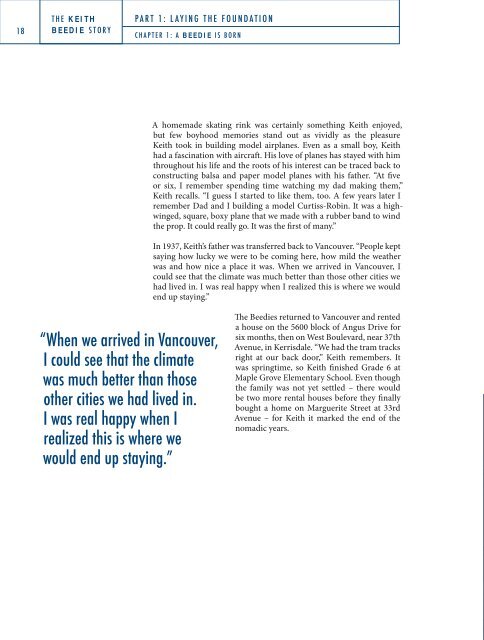Download The Keith Beedie Story - Beedie Group
Download The Keith Beedie Story - Beedie Group
Download The Keith Beedie Story - Beedie Group
You also want an ePaper? Increase the reach of your titles
YUMPU automatically turns print PDFs into web optimized ePapers that Google loves.
THE KEITH<br />
PART 1: LAYING THE FOUNDATION<br />
36 BEEDIE STORY<br />
CHAPTER 2: LEARNING THE HARD WAY<br />
37<br />
A Catalina patrol fl oat<br />
plane, circa 1944.<br />
THE CATALINA<br />
After working on the wings of so many Catalinas, <strong>Keith</strong> developed a lifelong love of the plane. In a small but<br />
signifi cant way, he helped construct one of the most widely used aircraft in World War II. Often considered<br />
awkward or clumsy, the “fl ying boat” proved to be an extraordinarily dependable machine. It had an exceptional<br />
operational range, and it could land on water anywhere in the open ocean, making it a very versatile aircraft. A<br />
construction cost of only $90,000 added to its popularity. <strong>The</strong> Catalina had a wide range of uses, from antisubmarine<br />
warfare, to marine patrol and search and rescue, to night-att ack capabilities. It even served as a<br />
commercial passenger plane for two years during the war, fl ying for Quantas in Australia.<br />
<strong>The</strong> Catalina was so successful that, unlike many other war planes, it was commonly found in commercial use<br />
in peacetime. Many were converted for aerial fi refi ghting, and others were used for mail service to remote<br />
areas. <strong>The</strong> last active military Catalina wasn’t retired until the 1980s. An estimated 4,051 were built.<br />
Despite a deep aff ection for the Catalina – and despite a couple of close calls – <strong>Keith</strong> has never been up in his<br />
favourite plane. Ironically, Bett y has fl own in one. She went up with her sister’s husband, Frank, who was an<br />
aircraft mechanic going north for a repair job, before she met <strong>Keith</strong>. For Bett y it was fun, but no big deal; for<br />
<strong>Keith</strong>, such a chance would have been a dream come true.<br />
Years later, George Hayhoe noticed a Catalina parked outside the Nanaimo airport. It looked as though it had<br />
been there for years, slowly falling apart. Knowing how much <strong>Keith</strong> loved the plane, George told him what he’d<br />
seen. <strong>Keith</strong> immediately contacted the Comox Air Museum to fi nd out if they would be interested in displaying<br />
the Catalina if he could purchase it. “I spoke to Captain Day, who was very excited at the idea,” says <strong>Keith</strong>.<br />
<strong>Keith</strong> managed to track down the owner of the plane, a captain in the Miramar military. After a number of<br />
emails back and forth, the two agreed on a purchase price of $80,000 for the Catalina. “I knew I needed to<br />
get an agreement from the museum before I went through with it, though,” says <strong>Keith</strong>. While Captain Day<br />
was keen, the fi nal decision had to go to a committ ee. <strong>The</strong> problem was that most of the committ ee was on<br />
summer vacation and they wouldn’t be able to hand down a decision for at least two months. <strong>Keith</strong> explained<br />
that he couldn’t wait that long. Instead, he contacted Stocky Edwards, a renowned RCAF fi ghter pilot of his<br />
acquaintance who sat on the same committ ee. Stocky said he would expedite the committ ee’s decision. “A<br />
few days later, I got a lett er from Comox. <strong>The</strong>y said ‘no,’ because they had no way to transport the plane, no<br />
place to store it and not enough volunteers to refurbish it. I was extremely disappointed after all the time I<br />
had spent on it.” <strong>The</strong> plane still sits exposed to the elements in the Nanaimo Airport.<br />
Photo: City of Vancouver Archives, P1.4.<br />
EXCERPT FROM “THE WAR WORKER,” BY DAVID TAYLOR<br />
David Taylor, an amateur poet, worked at the Boeing plant in Vancouver. He wrote this poem about his<br />
experiences during the war. Taylor gifted the poem to the Sea Island Historical Society. <strong>The</strong> poem gives a<br />
taste of what life at Boeing would have felt like for workers like <strong>Keith</strong>.<br />
Out on Sea Island at Boeing’s big plant<br />
the War Workers labor away.<br />
<strong>The</strong>y’re building Catalina and Canso, aircraft<br />
to hasten the dawn of V-day.<br />
<strong>The</strong> big planes are starting to take on their shape<br />
as they move out of Shop ninety nine.<br />
Each day they keep growing like some living thing<br />
as they move down the assembly line.<br />
Some planes now completed are out on the tarmac<br />
the Airforce inspection is through.<br />
This scene brings a thrill that would never be told,<br />
by old War Workers like me and like you.<br />
<strong>The</strong>n it’s on with the routine of building more<br />
aircraft, for the boys overseas are still dying.<br />
We must “Carry On” as the War Posters say “Buy<br />
Bonds” just to help “Keep ‘Em Flying.”


